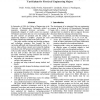502 search results - page 3 / 101 » Design requirements for technologies that encourage physical... |
CSCW
2008
ACM
13 years 9 months ago
2008
ACM
The global obesity epidemic has prompted our community to explore the potential for technology to play a stronger role in promoting healthier lifestyles. Although there are severa...
ER
2008
Springer
13 years 9 months ago
2008
Springer
Abstract. Current e-business technology enables the execution of increasingly complex coordination processes that link IT services of different companies. Successful design of cros...
OZCHI
2009
ACM
14 years 2 months ago
2009
ACM
People use a wide range of intensity when interacting with computers, spanning from subtle to brute force. However, computer interfaces so far have mainly focused on interactions ...
HICSS
2002
IEEE
14 years 10 days ago
2002
IEEE
In September of 1998, the College of Engineering at the University of Massachusetts Dartmouth piloted an innovative, integrated, first-year curriculum. It dramatically changed 31 ...
CHI
2011
ACM
12 years 11 months ago
2011
ACM
vSked is an interactive and collaborative assistive technology for students with autism, combining visual schedules, choice boards, and a token-based reward system into an integra...


